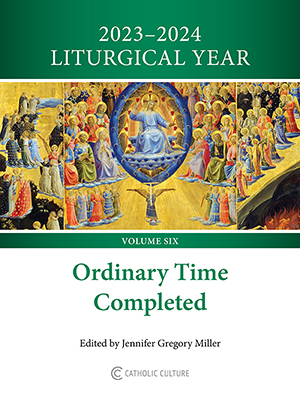A Sunday Feast: the Presentation of the Lord
By Jennifer Gregory Miller ( bio - articles - email ) | Jan 28, 2020 | In The Liturgical Year
 This Sunday, February 1, 2020, will be the celebration of the Feast of the Presentation of the Lord, also known as the Purification of Mary or Candlemas. This feast of our Lord supersedes the Fourth Sunday in Ordinary Time.
This Sunday, February 1, 2020, will be the celebration of the Feast of the Presentation of the Lord, also known as the Purification of Mary or Candlemas. This feast of our Lord supersedes the Fourth Sunday in Ordinary Time.
I have written on different aspects of this feast in the past, including how this is NOT the real end of the Christmas season even “traditionally.” I discussed this feast of light and the blessing of candles, and also how I love the Canticle of Simeon especially because of a family association. With this feast being celebrated on a Sunday, it brings a few more observations about the Presentation of the Lord.
When Does a Feast “Bump” A Sunday Liturgy?
A few years ago I wrote a post, Reading the Fine Print for the Liturgical Calendar, during which I addressed the exceptions to the rule in the Liturgical Year regarding Sundays and solemnities. I touched on the times of the year when a solemnity takes the place of a Sunday liturgy. What I did not discuss is the situations when feasts can supersede Sundays during the year.
As a reminder, when the General Liturgical Calendar was revised in 1969, the nomenclature of celebrations was changed, using more religious and traditional terms. Instead of terms like double, semidouble or different grades of class, I, II, III, etc., the grading of celebrations was greatly simplified, starting with the highest rank of Solemnity, then Feast, then Obligatory Memorial and finally Optional Memorial. The main liturgical document reference for understanding the structure and order of the Liturgical Year is the General Norms of the Liturgical Year and Calendar (GNYLC) from February 14, 1969. This document contains the “Table of the Order of Precedence.” My previous post concentrated on Part I of the Table which focuses on the highest ranking of solemnities and particular liturgical seasons. Today we are looking at Part II of the Table, where different feasts are ranked and how they affect Sunday.
Part II of the Table begins with Feasts of the Lord ranking over Sundays during Christmas and Ordinary Time:
II
5
6
- Sundays of the Christmas season and Sundays in Ordinary Time
7
- Feasts of the Blessed Virgin Mary and of the saints in the General Calendar
8
a. Feast of the principal patron of the diocese.
b. Feast of the anniversary of the dedication of the cathedral.
c. Feast of the principal patron of a region or province, or a country, or of a wider territory.
d. Feast of the title, founder, or principle patron of an order or congregation and of a religious province, without prejudice to the directives in no. 4.
e. Other feasts proper to an individual church.
f. Other feasts listed in the calendar of a diocese or of a religious order or congregation.
- Proper feasts, namely:
9
- Weekdays of Advent from 17 December to 24 December, inclusive
- Days within the Octave of Christmas
- Weekdays of Lent
Feasts are naturally lower in rank under solemnity, but they have specific liturgical characteristics and exceptions if they fall on Sunday. According to the GNLYC:
13. Feasts are celebrated within the limits of the natural day and accordingly do not have Evening Prayer I. Exceptions are feasts of the Lord that fall on a Sunday in Ordinary Time and in the Christmas season[b] and that replace the Sunday office. [R2]
Earlier in the document there is a description of the Liturgical Day and importance of Sunday, and how there are rare exceptions to budging of the liturgy of Sunday (emphasis is mine):
4. The Church celebrates the paschal mystery on the first day of the week, known as the Lord’s Day or Sunday. This follows a tradition handed down from the apostles and having its origin from the day of Christ’s resurrection. Thus Sunday must be ranked as the first holyday of all;
5. Because of its special importance, the Sunday celebration gives way only to solemnities or feasts of the Lord. The Sundays of the seasons of Advent, Lent, and Easter, however, take precedence over all solemnities and feasts of the Lord. Solemnities occurring on these Sundays are observed on the Saturdays preceding.
Due to the nature of being a “Feast of the Lord” falling on Sunday in Ordinary Time, Sunday’s Feast of the Presentation of the Lord is elevated similar to a solemnity and/or Sunday. You can laugh at my bad analogy, but if one were to think of the Table I and Table II of the GNLYC as tables for Thanksgiving dinner, Table I (with solemnities) is the adult table, and Table II (with feasts) is the children’s table. It’s a big deal and a rare exception that someone from the lower table (a feast) gets called up to Table I with the top dignitaries/adults.
No other kind of feasts (with one exception, Dedication of the Lateran Basilica on November 9) gets elevated to a Sunday celebration within the General Roman Calendar.
When Are These Exceptions?
Throughout the Liturgical Year there are 26 total possible feasts, 2 movable (Holy Family and Baptism of the Lord) and 24 on fixed dates. The types of feasts vary:
5 Feasts of the Lord
2 Feasts of the Blessed Virgin Mary
11 Feasts of Apostles and Evangelists
8 others, various
The Feasts of the Lord fall only during the Christmas season and Ordinary Time:
During the Christmas Season:
- Feast of the Holy Family of Jesus, Mary and Joseph (Sunday within the Octave of Christmas (or, if there is no such Sunday, 30 December)
- Feast of the Baptism of the Lord, Sunday after Epiphany (or, if Epiphany is celebrated on 7 or 8 January, the following Monday)
During Ordinary Time:
- February 2, Feast of the Presentation of the Lord
- August 6, Transfiguration of the Lord
- September 14, Exaltation of the Holy Cross
I guess one would say I “geek out” when figuring out the feast days of the upcoming Liturgical Year. I see it as a little similar to looking ahead at the calendar and seeing when family birthdays will land—will they be on weekdays or weekends? It makes a difference on how we will celebrate them, because we have more time with family to celebrate on the weekend. Because the Presentation of the Lord falls on Sunday this year, there is more time for celebration, such as the full procession and blessing of candles. Weekdays are harder to add liturgical celebrations when schedules are tight due to school and work.
Wait, Isn’t This a Feast of Mary?
 One confusion that often arises is whether Sunday’s feast of the Presentation is a feast of Mary or not. For those following the 1962 Extraordinary Form Calendar, the feast for February 2nd is officially entitled as “Purification of the Blessed Virgin Mary.” This name dates back at least to the Council of Trent calendar reform (1568). The Purification is not an ideal title and can be easy to misunderstand. Mary is completely sinless, so why would she need to be purified? The current calendar (reformed in 1969) went back to the ancient name of the “Presentation of the Lord” which makes it more clear that this is primarily a feast of the Lord.
One confusion that often arises is whether Sunday’s feast of the Presentation is a feast of Mary or not. For those following the 1962 Extraordinary Form Calendar, the feast for February 2nd is officially entitled as “Purification of the Blessed Virgin Mary.” This name dates back at least to the Council of Trent calendar reform (1568). The Purification is not an ideal title and can be easy to misunderstand. Mary is completely sinless, so why would she need to be purified? The current calendar (reformed in 1969) went back to the ancient name of the “Presentation of the Lord” which makes it more clear that this is primarily a feast of the Lord.
Pope Saint Paul VI in his Apostolic Exhortation, Marialis Cultus, explains in further detail the emphasis of the traditional name:
The feast of February 2, which has been given back its ancient name, the Presentation of the Lord, should also be considered as a joint commemoration of the Son and of the Mother, if we are fully to appreciate its rich content. It is the celebration of a mystery of salvation accomplished by Christ, a mystery with which the Blessed Virgin was intimately associated as the Mother of the Suffering Servant of Yahweh, as the one who performs a mission belonging to ancient Israel, and as the model for the new People of God, which is ever being tested in its faith and hope by suffering and persecution (cf. Lk. 2:21-35).
So while on the Liturgical Calendar the “Presentation of the Lord” is ranked as a “feast of the Lord,” it’s not to the exclusion of Mary. We recognize and honor Mary’s role in this feast.
The Presentation of the Lord is a pivotal point in our celebration of the Liturgical Year. This feast points back to Christmas, as it is the last of the Infancy Narratives. It ends the unofficial “40 days period” since Christmas. But this feast also brings us closer to the celebration of the Paschal Mystery. We think of the Light revealing Himself to all nations, bringing us through Lent, Good Friday and Easter He returns as Christ Our Light!
With the Presentation falling on a Sunday, this raises our feast, and potentially gives more time to celebrate and contemplate the mystery of the Presentation of the Lord. Enjoy this elevated feast!
For Further Reading:
- Presentation of the Lord: A Light for the Nations
- Candlemas: A Feast of Light and Hope
- Christmas to Candlemas: When Is the Real End of the Christmas Season?
- The End of Christmas: Dispelling the Misconceptions
- Blessing of Candles and Propers of Mass for Ordinary (Current) Form
- Blessing of Candles and Propers of Mass for Extraordinary (1962) Form
And for February 3, the Feast of St. Blaise, the first use of the newly blessed candles:
All comments are moderated. To lighten our editing burden, only current donors are allowed to Sound Off. If you are a current donor, log in to see the comment form; otherwise please support our work, and Sound Off!








